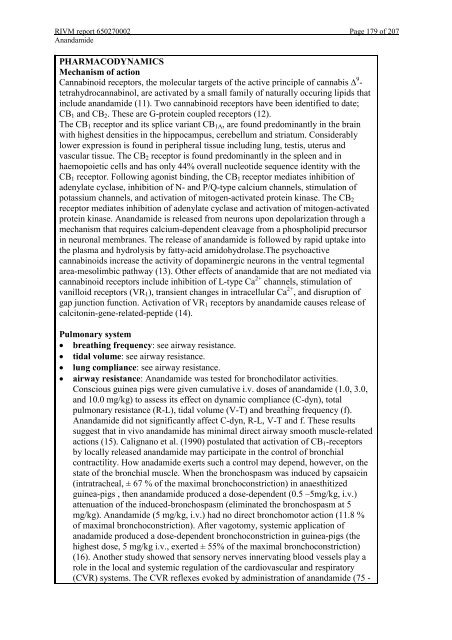The Contribution of cocoa additive to cigarette smoking addiction
The Contribution of cocoa additive to cigarette smoking addiction
The Contribution of cocoa additive to cigarette smoking addiction
Create successful ePaper yourself
Turn your PDF publications into a flip-book with our unique Google optimized e-Paper software.
RIVM report 650270002 Page 179 <strong>of</strong> 207<br />
Anandamide<br />
PHARMACODYNAMICS<br />
Mechanism <strong>of</strong> action<br />
Cannabinoid recep<strong>to</strong>rs, the molecular targets <strong>of</strong> the active principle <strong>of</strong> cannabis ∆ 9 -<br />
tetrahydrocannabinol, are activated by a small family <strong>of</strong> naturally occuring lipids that<br />
include anandamide (11). Two cannabinoid recep<strong>to</strong>rs have been identified <strong>to</strong> date;<br />
CB1 and CB2. <strong>The</strong>se are G-protein coupled recep<strong>to</strong>rs (12).<br />
<strong>The</strong> CB1 recep<strong>to</strong>r and its splice variant CB1A, are found predominantly in the brain<br />
with highest densities in the hippocampus, cerebellum and striatum. Considerably<br />
lower expression is found in peripheral tissue including lung, testis, uterus and<br />
vascular tissue. <strong>The</strong> CB2 recep<strong>to</strong>r is found predominantly in the spleen and in<br />
haemopoietic cells and has only 44% overall nucleotide sequence identity with the<br />
CB1 recep<strong>to</strong>r. Following agonist binding, the CB1 recep<strong>to</strong>r mediates inhibition <strong>of</strong><br />
adenylate cyclase, inhibition <strong>of</strong> N- and P/Q-type calcium channels, stimulation <strong>of</strong><br />
potassium channels, and activation <strong>of</strong> mi<strong>to</strong>gen-activated protein kinase. <strong>The</strong> CB2<br />
recep<strong>to</strong>r mediates inhibition <strong>of</strong> adenylate cyclase and activation <strong>of</strong> mi<strong>to</strong>gen-activated<br />
protein kinase. Anandamide is released from neurons upon depolarization through a<br />
mechanism that requires calcium-dependent cleavage from a phospholipid precursor<br />
in neuronal membranes. <strong>The</strong> release <strong>of</strong> anandamide is followed by rapid uptake in<strong>to</strong><br />
the plasma and hydrolysis by fatty-acid amidohydrolase.<strong>The</strong> psychoactive<br />
cannabinoids increase the activity <strong>of</strong> dopaminergic neurons in the ventral tegmental<br />
area-mesolimbic pathway (13). Other effects <strong>of</strong> anandamide that are not mediated via<br />
cannabinoid recep<strong>to</strong>rs include inhibition <strong>of</strong> L-type Ca 2+ channels, stimulation <strong>of</strong><br />
vanilloid recep<strong>to</strong>rs (VR1), transient changes in intracellular Ca 2+ , and disruption <strong>of</strong><br />
gap junction function. Activation <strong>of</strong> VR1 recep<strong>to</strong>rs by anandamide causes release <strong>of</strong><br />
calci<strong>to</strong>nin-gene-related-peptide (14).<br />
Pulmonary system<br />
breathing frequency: see airway resistance.<br />
tidal volume: see airway resistance.<br />
lung compliance: see airway resistance.<br />
airway resistance: Anandamide was tested for bronchodila<strong>to</strong>r activities.<br />
Conscious guinea pigs were given cumulative i.v. doses <strong>of</strong> anandamide (1.0, 3.0,<br />
and 10.0 mg/kg) <strong>to</strong> assess its effect on dynamic compliance (C-dyn), <strong>to</strong>tal<br />
pulmonary resistance (R-L), tidal volume (V-T) and breathing frequency (f).<br />
Anandamide did not significantly affect C-dyn, R-L, V-T and f. <strong>The</strong>se results<br />
suggest that in vivo anandamide has minimal direct airway smooth muscle-related<br />
actions (15). Calignano et al. (1990) postulated that activation <strong>of</strong> CB1-recep<strong>to</strong>rs<br />
by locally released anandamide may participate in the control <strong>of</strong> bronchial<br />
contractility. How anadamide exerts such a control may depend, however, on the<br />
state <strong>of</strong> the bronchial muscle. When the bronchospasm was induced by capsaicin<br />
(intratracheal, ± 67 % <strong>of</strong> the maximal bronchoconstriction) in anaesthitized<br />
guinea-pigs , then anandamide produced a dose-dependent (0.5 –5mg/kg, i.v.)<br />
attenuation <strong>of</strong> the induced-bronchospasm (eliminated the bronchospasm at 5<br />
mg/kg). Anandamide (5 mg/kg, i.v.) had no direct bronchomo<strong>to</strong>r action (11.8 %<br />
<strong>of</strong> maximal bronchoconstriction). After vago<strong>to</strong>my, systemic application <strong>of</strong><br />
anadamide produced a dose-dependent bronchoconstriction in guinea-pigs (the<br />
highest dose, 5 mg/kg i.v., exerted ± 55% <strong>of</strong> the maximal bronchoconstriction)<br />
(16). Another study showed that sensory nerves innervating blood vessels play a<br />
role in the local and systemic regulation <strong>of</strong> the cardiovascular and respira<strong>to</strong>ry<br />
(CVR) systems. <strong>The</strong> CVR reflexes evoked by administration <strong>of</strong> anandamide (75 -
















